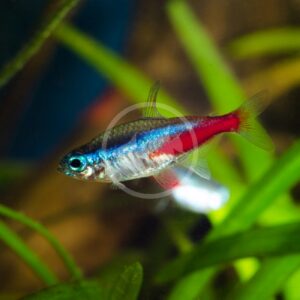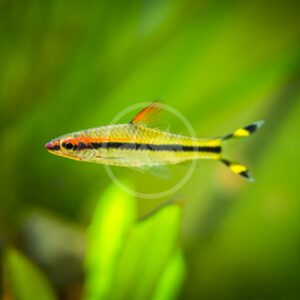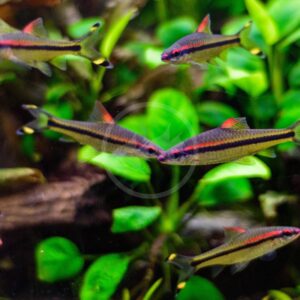CATFISH – GULPER / OGRE
Asterophysus batrachus
$69.99
The Gulper Catfish, also referred to as the Ogre Catfish, is found in blackwater tributaries of the Rio Negro and Orinoco drainages of Brazil and Venezuela. Gulper catfish are overall brown in color and are very stocky, named after their particularly cavernous mouths. Gulper catfish do not make for good candidates as scavenging fish due to their predatory nature. They can eat a fish at least half their body size, so careful thought must go into choosing tank mates to keep alongside this species. Aim for fish that are at least twice the size of your Gulper catfish. It is best to only keep one Gulper catfish per aquarium. Gulper catfish are more nocturnal in nature, so its activity level during the day may be limited. This catfish is scaleless, making it very sensitive to water chemistry parameters and medications. An adult Gulper catfish can reach a size of approximately 10″.
Out of stock
Care Level: Advanced
Temperament: Semi-Aggressive
Live Plant Safe: With Caution
General Description: The Gulper Catfish, also referred to as the Ogre Catfish, is found in blackwater tributaries of the Rio Negro and Orinoco drainages of Brazil and Venezuela. Gulper catfish are overall brown in color and are very stocky, named after their particularly cavernous mouths. Gulper catfish do not make for good candidates as scavenging fish due to their predatory nature. They can eat a fish at least half their body size, so careful thought must go into choosing tank mates to keep alongside this species. Aim for fish that are at least twice the size of your Gulper catfish. It is best to only keep one Gulper catfish per aquarium. Gulper catfish are more nocturnal in nature, so its activitiy level during the day may be limited. This catfish is scaleless, making it very sensitive to water chemistry parameters and medications. An adult Gulper catfish can reach a size of approximately 10″.
Diet Requirements: In the wild Gulper catfish are carnivores. A Gulper catfish can usually adapt to a prepared food protein-rich diet once it realizes that such items are, in fact, food. Options should include frozen brine shrimp, mussels, krill, silverside fish, prawns, or whitefish. Appropriate frozen food options will vary depending on the size of your specimen. Earthworms make for an excellent treat. Gulper catfish may accept sinking pellet foods, but these should not make up the majority of their diet. Variety is the spice of life in order to maintain color, immune function and longevity of your fish. Even though this species is predatory in nature, we discourage feeding live fish because they are often of little nutritional value and increase the risk of introducing disease. Gut loaded ghost shrimp, that is ghost shrimp fed prior to being fed to the Gulper catfish, are a safe alternative to entice feeding behavior. Do not feed any form of mammalian/poultry meat (e.g., beef or chicken) as certain lipids in these cannot be metabolized by the Gulper catfish, which is detrimental to their health. Adult specimens only need to be fed once or twice a week.
Care Requirements: A minimum 125 to 150 gallon aquarium is ideal for a Gulper catfish. This species should not be introduced into a biologically immature aquarium, as it is sensitive to nitrite and ammonia. Weekly water changes are necessary to keep water parameters pristine (Nitrates < 20 ppm) as Gulper catfish do not like high nitrates and deteriorating water parameters. Equipping the aquarium a canister filter, or a sump system, is also suggested to maintain a more high quality environment for this scaleless species and combat the amount of waste it produces. The aquarium should be aquascaped with copious rocks and driftwood for coverage and places to hide during the day. Floating plants would help to dim intense lighting. Catfish require a sandy to fine substrate; too coarse of a substrate could cause injury to their barbels. The Gulper catfish is not overly aggressive in nature, though its large mouth and predatory behavior makes it a very challenging species to integrate into the home aquarium. Do not house a Gulper catfish with species that will nip at its delicate whiskers. Recommended water conditions, 72-78° F, KH 2-12, pH 5.0-7.0.
Purchase Size: Medium: 3” to 4”
Note: Your item may not look identical to the image provided due to variation within species. Purchase sizes are approximate.
Dry goods orders are shipped via US Postal Service or UPS to the address provided at checkout based on the selection made in your website shopping cart. Product is carefully packed to help prevent any damage during shipping. Once processed you will receive a shipment notification via email with tracking number, and delivery notification. Please allow 48 hours for processing after your order is placed.
Perishable items (i.e. live plants, refrigerated/frozen foods) are shipped via US Postal Service 2-3 day to the address provided at checkout for a $25.00 flat rate charge. Items are packed with secure packing material and heat, cold, or Cryo packs as needed to maintain safe temperatures during transit. If one or more perishable items are in the shopping cart at checkout the $25.00 perishable shipping charge will automatically appear and need to be selected. Once processed you will receive a shipment notification via email with tracking number. Please allow 48 hours for processing after your order is placed.
Livestock (i.e. fish, invertebrates, coral) are shipped via UPS Overnight to the address provided at checkout for a $55.00 flat rate charge. Livestock is packed in insulated styrofoam boxes with secure packing material and heat, cold, or Cryo packs as needed to maintain safe temperatures during transit. If one or more livestock items are in the shopping cart at checkout the $55.00 livestock shipping charge will automatically appear and need to be selected. Livestock is shipped Monday through Wednesday ONLY (no weekend delivery is available) weather permitting, and we reserve the right to delay shipping until conditions are appropriate for safe arrival. Once your order is placed we will contact you to arrange the best shipping date based on these criteria. Someone must be available to receive the livestock order on the first delivery attempt. Once processed you will receive a shipment notification via email with tracking number. Please allow 48 hours for processing after your order is placed.
For mixed dry goods/perishable & livestock orders items will be shipped via their corresponding shipping methods outlined above. Dry goods will be shipped via US Postal Service or UPS based on your selection and checkout, while livestock will ship via UPS Overnight for a $55.00 flat rate charge. You will receive separate notifications and tracking numbers for the dry goods and livestock. Please note due to different carriers and shipping methods dry goods and livestock may arrive on different days.
Related products

PLECOSTOMUS – BRISTLENOSE / BUSHYNOSE
Ancistrus sp.
$4.79 – $79.99

TETRA – NEON
Paracheirodon innesi
$6.99
BARB – DENISONII / ROSELINE SHARK
Sahyadria denisonii
$9.99 – $79.99

PLECOSTOMUS – BRISTLENOSE ALBINO / GOLD
Ancistrus sp.
$4.79 – $47.99

BARB – CHERRY
Puntius titteya
$3.99 – $9.99

CICHLID – RAM GERMAN GOLD
Mikrogeophagus ramirezi
$5.99 – $16.99

AXOLOTL – ALBINO
Ambystoma mexicanum
$99.99 – $149.99





